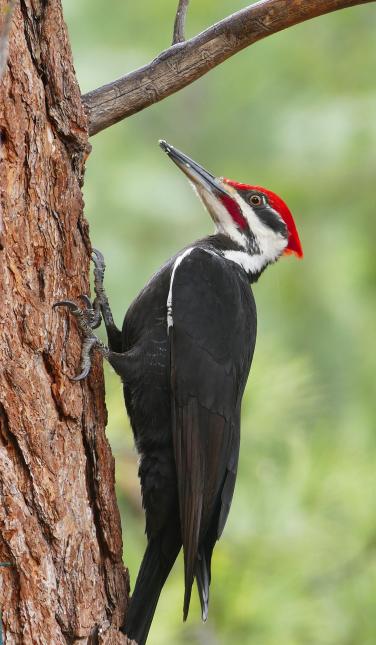Finding Woodpeckers in Florida: Types Variety and Natural History
Finding Woodpeckers in Florida: Types Variety and Natural History
Blog Article
Discover the Fascinating Globe of Woodpeckers: Every Little Thing You Need to Know
The globe of woodpeckers is a realm loaded with unique actions, intricate adjustments, and a diverse variety of varieties. From their habitats and circulation patterns to their feeding habits and specialized anatomical attributes, woodpeckers have long astounded the rate of interest of ornithologists and nature fanatics alike. Recognizing the intricacies of these remarkable birds provides a glimpse into the complex interaction in between their biology and the setting. As we check out the world of woodpeckers better, we reveal a wide range of information that clarifies their relevance in ecosystems and the obstacles they deal with in an ever-changing world.
Woodpecker Habitats and Distribution
Woodpeckers live in a varied series of settings worldwide, showcasing versatility in their circulation patterns. These resistant birds are found in woodlands, forests, savannas, and deserts across numerous continents, demonstrating their ability to thrive in different weather problems. In The United States and Canada, as an example, woodpeckers can be found in both coniferous and deciduous woodlands, using their strong beaks to forage for insects and create nesting tooth cavities in trees. In Africa, particular woodpecker types have actually adapted to arid environments, such as the acacia woodlands, where they play a critical function in controlling insect populaces.

Feeding Behaviors and Diet Plan
Woodpeckers utilize their strong beaks to pierce into the bark of trees, penetrating for bugs and larvae hidden beneath the surface area. In addition to insects, woodpeckers likewise eat nuts, seeds, fruits, and sap.
Woodpeckers are known for their drumming habits, which serves not only to interact with other woodpeckers however also to situate food. The fast drumming audio is developed by the bird pecking on resonant surfaces like dead trees or steel poles. This behavior can draw in bugs hidden in the timber, enabling the woodpecker to spot their existence and eat them.
Unique Adjustments for Tree Climbing
In their skilled pursuit of pests hidden within tree bark, woodpeckers have actually advanced impressive physiological functions that equip them with distinct adjustments for reliable tree climbing. One of the key adaptations is their zygodactyl feet, with two toes directing onward and 2 pointing backwards, providing a solid hold on tree trunks. This customized foot arrangement enables woodpeckers to cling to upright surface areas effortlessly, allowing them to relocate up and down trees with agility. In addition, woodpeckers have stiff tail plumes that act as a helpful prop while they climb, assisting in equilibrium and security. Their strong, chisel-like beaks are not just utilized for exploration into wood but also for clutching onto bark as they ascend tree trunks. Furthermore, woodpeckers have strong neck muscle mass and a distinct head framework that soak up the impact of consistent pecking, allowing them to climb vertically without creating damage to their minds. These adaptations display the extraordinary transformative layout that makes it possible for woodpeckers to navigate trees with accuracy and efficiency.
Diverse Woodpecker Types Worldwide
With over 200 different types spread out throughout numerous habitats worldwide, the family members of Picidae incorporates an impressive diversity of woodpeckers. These birds can be found in woodlands, timberlands, savannas, and even urban areas, showcasing their flexibility to different atmospheres. From the iconic Northern Flicker in The United States And Canada to the colorful and evasive Crimson-backed Flameback in Asia, each woodpecker types exhibits special qualities in regards to tuft, habits, and environment preference.
Woodpeckers vary significantly in dimension, with the small Downy Woodpecker gauging around 6-7 inches in length, while the effective Lineated Woodpecker can rise to 17 inches - Woodpeckers in Florida. Their beaks also are available in different sizes and shapes, mirroring their feeding routines. Some varieties specialize in removing insects from tree bark, like Bonuses the Acorn Woodpecker, while others, such as the Black-cheeked Woodpecker, prey on fruits and seeds

Conservation Efforts and Obstacles
Conservation efforts for woodpecker populations are critical in alleviating the impact of habitat loss and other threats facing these diverse avian types. Woodpeckers deal with different obstacles to their survival, mainly because of deforestation, urbanization, environment modification, and invasive types. To deal internet with these concerns, conservation efforts focus on safeguarding and recovering woodpecker environments, applying sustainable forestry methods, and elevating recognition about the importance of these birds in ecological communities.
One substantial obstacle in woodpecker preservation is the fragmentation of their habitats, bring about separated populations that are much more vulnerable to extinction - Woodpeckers in Florida. Preservationists work to develop wild animals hallways and shielded locations that connect these fragmented habitats, permitting woodpeckers to move in between different locations for feeding, reproducing, and shelter

Final Thought
In verdict, woodpeckers are remarkable birds with unique adaptations for tree climbing and feeding habits. They can be discovered in varied habitats worldwide, click here for more info encountering conservation difficulties as a result of environment loss and human tasks. Recognizing their environments, diet plans, and habits is critical for preservation initiatives to shield these essential bird types. More study and preservation actions are needed to make sure the survival of woodpeckers in the wild.
Report this page